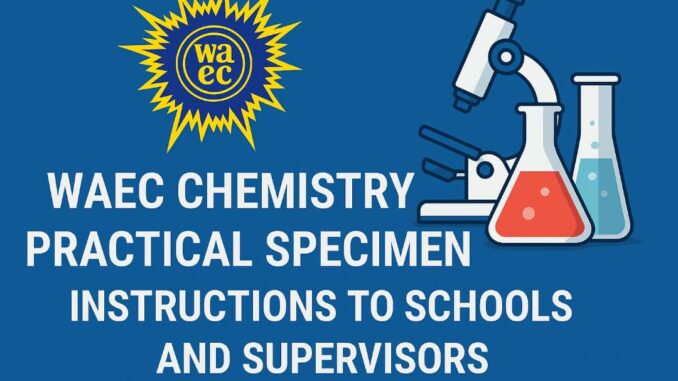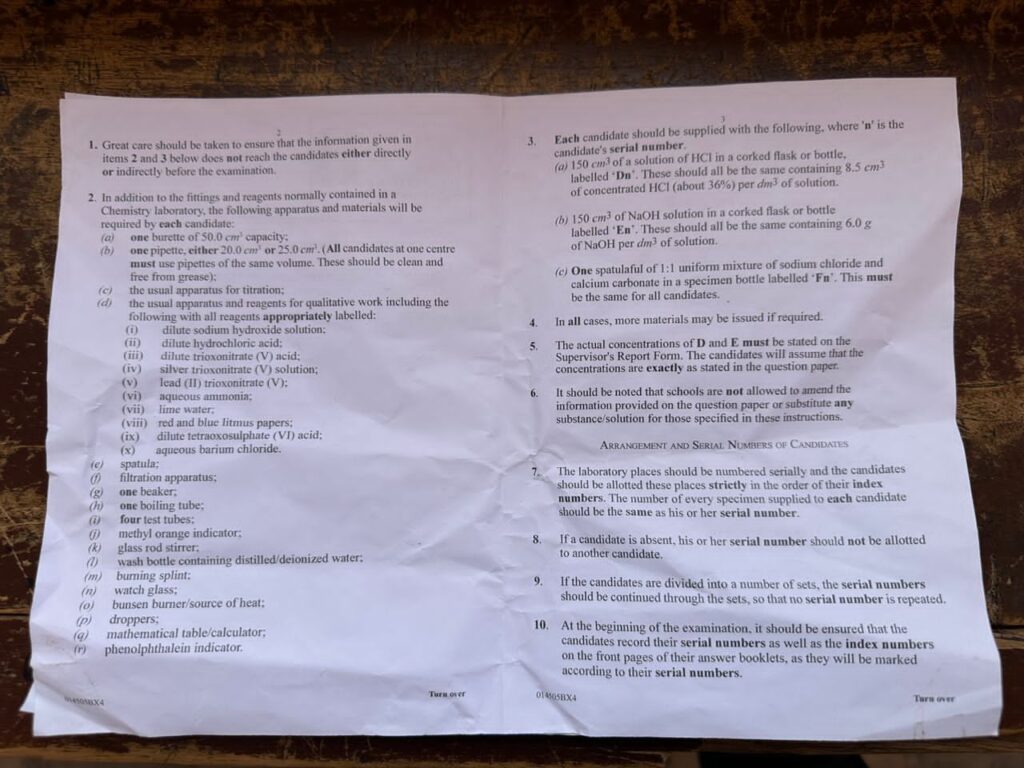
The West African Examinations Council (WAEC) Chemistry (Alternative B) Practical examination is a crucial assessment that tests students’ laboratory skills, analytical reasoning, and understanding of chemical principles. To ensure a smooth and fair examination process, strict adherence to specimen handling, apparatus setup, and safety protocols is required.
This comprehensive guide provides detailed instructions on the 2025 WAEC Chemistry Practical specimen, required materials, safety precautions, and key reminders for both candidates and supervisors.
2025 WAEC CHEMISTRY ALTERNATIVE B PRACTICAL EXAMINATION SCHEDULE
Tuesday, 17th June 2025
First Set: 9:30 am – 11:30 am
Second Set: 12:00 noon – 2:00 pm
Important Notice: Confidentiality of Specimen
Great care must be taken to ensure that the information regarding apparatus, reagents, and specimen does not reach candidates before the examination. This prevents malpractice and ensures fairness.


List of Required Apparatus and Materials
Each candidate must have access to the following:
1. Titration Setup
- One 50.0 cm³ burette
- One pipette (20.0 cm³ or 25.0 cm³)
- All candidates in a center must use the same pipette volume.
- Pipettes must be clean and grease-free.
- Standard titration apparatus (retort stand, clamp, conical flask, white tile)
2. Qualitative Analysis Reagents (Properly Labeled)
Candidates will perform tests using:
- Dilute sodium hydroxide (NaOH)
- Dilute hydrochloric acid (HCl)
- Dilute trioxonitrate(V) acid (HNO₃)
- Silver trioxonitrate(V) solution (AgNO₃)
- Lead(II) trioxonitrate(V) (Pb(NO₃)₂)
- Aqueous ammonia (NH₄OH)
- Lime water (Ca(OH)₂)
- Red & blue litmus papers
- Dilute tetraoxosulphate(VI) acid (H₂SO₄)
- Aqueous barium chloride (BaCl₂)
3. General Laboratory Equipment
- Filtration apparatus (funnel, filter paper, beaker)
- One beaker
- One boiling tube
- Four test tubes
- Glass rod (for stirring)
- Wash bottle with distilled/deionized water
- Bunsen burner or heat source
- Burning splint (for gas tests)
- Watch glass
- Droppers
- Spatula
4. Indicators
- Methyl orange
- Phenolphthalein
5. Additional Materials
- Mathematical tables/calculator
Specimen for Each Candidate (Serial Number = ‘n’)
Each candidate will receive:
- 150 cm³ of HCl solution (in a corked flask labeled ‘Dn’)
- Concentration: 8.5 cm³ of conc. HCl (~36%) per dm³.
- 150 cm³ of NaOH solution (in a corked flask labeled ‘En’)
- Concentration: 6.0 g NaOH per dm³.
- One spatulaful of a 1:1 mixture of NaCl and CaCO₃ (labeled ‘Fn’)
Note:
- More materials may be issued if needed.
- Actual concentrations of D & E must be recorded on the Supervisor’s Report Form.
- Candidates will assume concentrations are as stated in the question paper.
Supervisor’s Responsibilities
1. Serial Number Allocation
- Lab benches must be numbered serially.
- Candidates must be seated in order of their index numbers.
- Absent candidates’ numbers must not be reassigned.
- If multiple sets are used, serial numbers must continue without repetition.
2. Verification of Titration Results
Supervisors must perform the same titrations as candidates. Results should be recorded to at least three decimal places to avoid discrepancies.
3. Reporting Issues: Any difficulties faced by candidates (e.g., faulty apparatus) must be reported.
4. Safety Briefing
- Before the exam, read the following to candidates:
“Chemicals can be dangerous if mishandled. Work carefully. If you experience irritation, call the invigilator immediately. Rinse your mouth with water if any chemical enters it. Wash hands thoroughly after handling chemicals.”
Expected Experiments
Candidates should prepare for:
Volumetric Analysis – Acid-base titration (HCl vs. NaOH).
Qualitative Analysis – Identifying ions in mixture ‘Fn’ (NaCl + CaCO₃).
Gas Tests – Using lime water and burning splints.
Precipitation & pH Tests – Observing reactions with AgNO₃, BaCl₂, etc.
Safety Precautions for Candidates
- Wear protective gear (lab coat, gloves, goggles if available).
- Avoid direct contact with chemicals—use droppers and spatulas.
- Handle acids and bases with care—add acids to water, not vice versa.
- Dispose of waste properly—follow supervisor’s instructions.
- Report spills or accidents immediately.
Final Tips for Success
Practice titration techniques beforehand.
Label test tubes clearly to avoid mix-ups.
Record observations immediately (color changes, precipitates, gas evolution).
Double-check calculations—simple errors can cost marks.
Manage time wisely—allocate time for each section.
Conclusion
The WAEC 2025 Chemistry (Alternative B) Practical demands precision, safety awareness, and careful observation. By following these guidelines, candidates can approach the exam confidently, while supervisors ensure a smooth and fair assessment process.
Best of luck to all candidates!

Leave a Reply